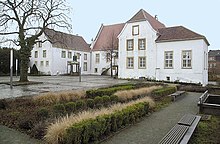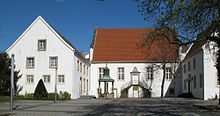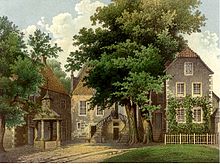Villa Reni

The Villa Reni is a Carolingian royal estate, which was probably built at the end of the 8th or beginning of the 9th century and became the nucleus of today's city of Rheine . The first documentary mention of the Villa Reni in a deed of donation from Ludwig the Pious comes from the year 838. The establishment of the royal estate occurred against the background of the Franconian missionary and occupation policy in the course of Charlemagne's Saxon Wars .
The estate was given the name Falkenhof, which still exists today, in 1437 after the owner of Valke at the time . In its overall impression, the Falkenhof looks like a baroque complex today; in fact, however, the Falkenhof grew into its present-day appearance over the centuries. The shape typical of Franconian royal estates has been preserved for the entire courtyard. The facility is now owned by the city of Rheine and serves as a museum for art and history as well as a location for cultural events.
History of the Villa Reni and the Falkenhof
founding
The Villa Reni was founded against the backdrop of the Saxon Wars (772 to 805) of Charlemagne. After partial victories over the Saxon tribe of Westphalia , Karl began a settlement, missionary and occupation policy to integrate the Saxons into the Frankish Empire .
First of all, the Emsfurt, located in Rheine, had to be secured against the still restless Saxons. To this end, the Franconians rebuilt the fortified, rectangular Villa Reni royal court , about 150 by 75 meters, on a hill directly on the western bank of the Ems . In terms of its economic structure, a villa, the name for a medieval manor, roughly corresponds to that of a small village. The estate also served as a supply station for Franconian warriors who passed through.
The Villa Reni not only protects the Emsfurt itself, but also two prehistoric long-distance paths that crossed in the immediate vicinity of the Villa Reni: These were the Hellweg in front of the Sandforde and the Friesische Straße . The Hellweg led from the IJsselstädten ( Zwolle , Deventer , Arnhem ) in what is now the Netherlands via Rheine to Bremen and into the East Westphalian region around Minden and to Paderborn. The Friesische Straße leading through Rheine is one of the seven long-distance trade routes documented by Charlemagne for the trade of the Frisians with the inland. In addition, the Friesische Strasse connected the young bishopric in Münster with its Emsland and Frisian districts.
Exactly when the Villa Reni was founded is not known, but there is probably a temporal proximity to the same events in Münster at the end of the 8th and beginning of the 9th century, because the missionary work of the Saxons by Münster's first Bishop Liudger and the Saxon Wars of Charles the Great Big ones fall into a narrow spatial and temporal framework. An older predecessor settlement on the site of Vila Reni has not been archaeologically documented. The first documentary mention of the Villa Reni can be found in a deed of gift from Emperor Ludwig the Pious , dated June 7, 838 , in which, along with other royal goods, he also assigned the Reni estate to the Herford monastery.
The Villa Reni (later also Rene ) gave the city of Rheine its name. One thesis takes the Celtic term reni as the origin of the name , which means something like "flow quickly"; Another thesis sees the roots of the word reni in the Old Saxon language. This term has been preserved in the High German words "rinnen" and "Rinne". Below the Falkenhof, the Ems flows rapidly through a narrow passage that is only about 50 meters wide, which, because of its high banks, can act like a channel; this was probably the reason for the naming of the farm.
The gentlemen of Villa Reni and the Falkenhof
The Herford Benedictine Abbey gave the farm as a fief to alternating noble families. The Lords of Hake were followed in 1371 by the Lords of Valke (also Valcke ), through whom the name Falkenhof is first documented for the year 1437. When Anna von Valke married Dietrich von Morrien in 1521, the farm fell to the von Morrien family , under whom the Falkenhof flourished. In 1809 the farm finally passed into non-aristocratic private ownership. From the middle of the 19th century, the Falkenhof was also open to the public. In 1949 the city of Rheine bought the farm and renovated it step by step until the 1970s.
|
Building history
The Falkenhof underwent its last major renovations and extensions in the run-up to the Regionale 2004 . During this renovation, underground corridors were discovered that could originally have been laid out as escape routes , but were used as waste pits by the residents of the estate from the 17th century at the latest. During the excavations, a large number of everyday objects from the 17th to the 19th century were discovered, some of which can be viewed in the museum today.
Literature: Fred Kaspar / Peter Barthold: The Falkenhof in Rheine. Investigations into the building history and significance. In: Zeitschrift Westfalen Volume 81 / Münster 2003, pp. 9–52.
Falkenhof Museum
The Municipal Museum has been in the Falkenhof since 1962. Since then, the collections have been steadily expanded and are now essentially divided into four thematic focuses:
City history
The Falkenhof Museum houses, among other things, a department for prehistory and early history in the Rheine settlement area. Weapons, tools, urns and household items are on display. The showpiece of the exhibition is an impression only a few millimeters thick of a 3500 year old body burial that was discovered under a burial mound in Altenrheine. Documentation of the city's military and arms history occupies a large area. Interactive with sound and images, visitors are guided through a spectacular exhibition of medieval weapons and the Rhine city fortifications.
Graphics cabinet
The graphics cabinet includes a collection of several thousand works, in which well-known artists such as Picasso , Goya and Dürer are represented. The graphics are presented in changing exhibitions under different artistic aspects.
Kasimir Hagen Collection
The Falkenhof Museum is proud of the art collection of Cologne's Kasimir Hagen (1887–1965), most of which is owned by the museum. The core of the collection is made up of paintings from the 20th century, romantic depictions of landscapes from the 19th century, works from the Biedermeier period and religious art. Some of the works in the graphics cabinet also come from the Kasimir Hagen collection.
Rheiner artist
Works by artists born or resident in Rheine with supraregional importance take up a large space, for example the painters Carl Murdfield , Carl Weddige , Ludwig Wenzel and Karl Wenzel , Carlo Mense and the sculptor Joseph Krautwald .
Web links
- City of Rheine - Falkenhof Museum
- Material on the Falkenhof in the Duncker Collection of the Central and State Library Berlin (PDF download; 242 kB)
- 360 ° panoramic image of the Falkenhof in the Westphalia Culture Atlas (requires Flash player )
- Falkenhof-Museum on the object portal museum-digital: westfalen
Coordinates: 52 ° 16 ′ 51 ″ N , 7 ° 26 ′ 12 ″ E






